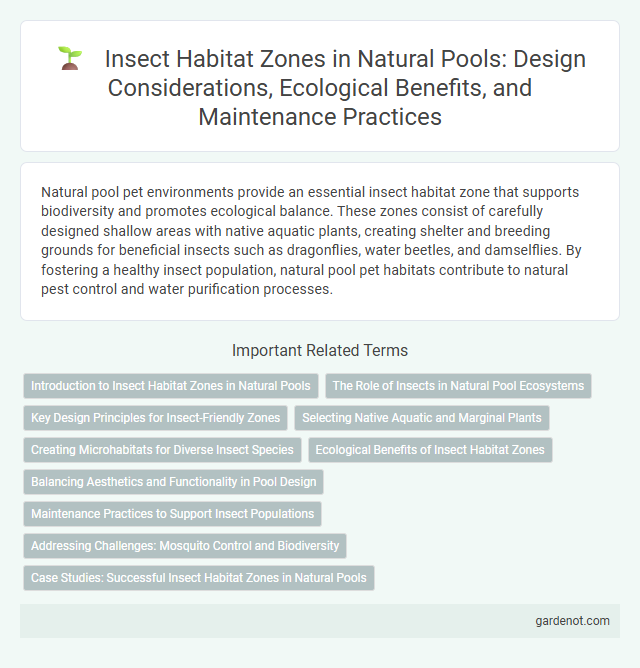Natural pool pet environments provide an essential insect habitat zone that supports biodiversity and promotes ecological balance. These zones consist of carefully designed shallow areas with native aquatic plants, creating shelter and breeding grounds for beneficial insects such as dragonflies, water beetles, and damselflies. By fostering a healthy insect population, natural pool pet habitats contribute to natural pest control and water purification processes.
Introduction to Insect Habitat Zones in Natural Pools
Insect habitat zones in natural pools are essential for maintaining biodiversity and ecological balance by providing specific environments for various aquatic and semi-aquatic insects. These zones typically include shallow, vegetated areas where insects can lay eggs, find food, and seek shelter from predators. Creating diverse microhabitats with native plants and varying water depths enhances the presence of pollinators, dragonflies, and other beneficial insect species critical to the pool's health.
The Role of Insects in Natural Pool Ecosystems
Insect habitat zones within natural pools provide essential breeding and feeding grounds for diverse insect species, which play a critical role in maintaining ecological balance. Insects such as dragonflies and water beetles contribute to natural pest control by preying on mosquito larvae, while also serving as a food source for amphibians and birds. Their presence enhances nutrient cycling and promotes water quality by breaking down organic matter, supporting a self-sustaining ecosystem.
Key Design Principles for Insect-Friendly Zones
Natural pool insect habitat zones prioritize diverse native plants to provide shelter and food sources for pollinators and beneficial insects, creating a balanced ecosystem. Designing varied water depths and incorporating debris like branches facilitate breeding and resting habitats, enhancing insect biodiversity. Integrating non-toxic materials and avoiding chemical treatments ensure a safe environment that supports insect populations crucial for natural pool health.
Selecting Native Aquatic and Marginal Plants
Selecting native aquatic and marginal plants is essential for creating a thriving insect habitat zone in a natural pool. Native species such as water lilies, pickerelweed, and sedges provide shelter, breeding grounds, and natural food sources for beneficial insects like dragonflies, damselflies, and water beetles. Incorporating a diverse range of native plants enhances biodiversity, supports the local ecosystem, and improves water quality through natural filtration.
Creating Microhabitats for Diverse Insect Species
Creating microhabitats in a natural pool's insect habitat zone fosters biodiversity by providing specialized environments for various insect species such as dragonflies, water beetles, and damselflies. Incorporating features like submerged logs, emergent plants, and shallow gravel beds enhances shelter, breeding sites, and foraging areas critical for insect life cycles. This habitat complexity supports ecological balance, improves water quality through natural pest control, and promotes pollination in adjacent vegetation.
Ecological Benefits of Insect Habitat Zones
Insect habitat zones in natural pools create diverse microhabitats that support a wide range of beneficial insect species, including pollinators and natural pest controllers. These zones enhance biodiversity by providing shelter, breeding grounds, and food sources essential for maintaining ecological balance within the aquatic ecosystem. By fostering insect populations, natural pools promote nutrient cycling and contribute to the overall health and resilience of the environment.
Balancing Aesthetics and Functionality in Pool Design
Insect habitat zones in natural pool designs support biodiversity by creating safe environments for pollinators and aquatic insects while maintaining water clarity through natural filtration. Strategically placing native vegetation and shallow ledges fosters insect life without compromising swimmer safety or aesthetic appeal. Balancing these zones enhances ecosystem health and integrates seamlessly with the pool's visual elegance, promoting sustainable water management.
Maintenance Practices to Support Insect Populations
Regularly removing excess debris from the insect habitat zone ensures optimal conditions for beneficial insect populations in natural pools. Maintaining diverse native plant species around the water edge provides shelter and food sources essential for sustaining aquatic and terrestrial insects. Avoiding chemical treatments preserves the delicate ecosystem balance, promoting biodiversity and natural pest control services.
Addressing Challenges: Mosquito Control and Biodiversity
In natural pools, the insect habitat zone plays a crucial role in maintaining ecological balance by supporting diverse species such as dragonflies and water beetles, which naturally control mosquito populations. Incorporating aquatic plants like submerged oxygenators and floating vegetation helps disrupt mosquito breeding while promoting biodiversity. Regular monitoring and water circulation further reduce stagnant areas, minimizing mosquito larvae development and enhancing overall habitat health.
Case Studies: Successful Insect Habitat Zones in Natural Pools
Case studies of successful insect habitat zones in natural pools highlight the integration of diverse native plant species that provide shelter and breeding grounds for beneficial insects like dragonflies and damselflies. These zones employ shallow water areas with submerged and emergent vegetation to support aquatic larvae, enhancing biodiversity and natural pest control. Research from established natural pools demonstrates increased insect population stability and improved ecosystem balance, validating these habitat designs.
Insect habitat zone Infographic

 gardenot.com
gardenot.com